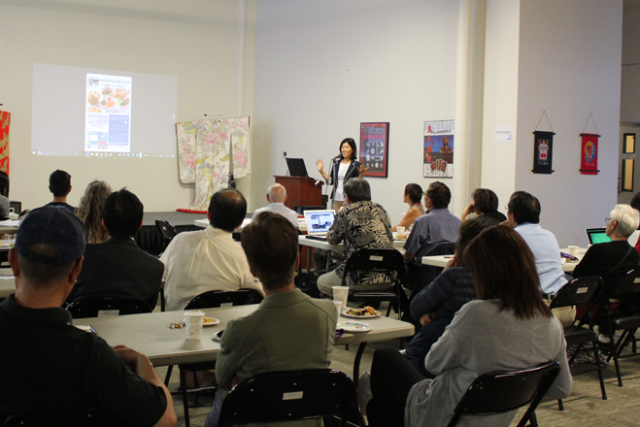
By David Yamaguchi
With this issue, the North American Post transitions from a weekly to a twice-a-month paper. It also features a new, more modern-looking layout with more English content and more color.
The thinking behind the new format was presented and discussed among about thirty invited participants close to this paper on July 18. The individuals span a cross section of staff, advisory board members, and Japanese community leaders.
WHY CHANGE? Publisher Tomio Moriguchi and others spelled it out for all at the meeting. To date, the Post has been a “Jiichan-Baachan” [grandpa-grandma] elderly person’s paper. As the numbers of this core readership are declining, to continue to do so, and not evolve with the times, would be to die a slow death.
To elaborate, the present status quo is that Mr. Moriguchi owns both the Post and Soy Source. The latter is a semi-monthly Japanese language newspaper that caters to the basic-information needs of new immigrants from Japan. The Post has been losing money while Soy Source has been making it. So Soy Source has been supporting the Post financially.
The situation is analogous to that faced by the Northwest Asian Weekly and its Chinese-language counterpart, the Seattle Chinese Post, both published by Assunta Ng. The broader social forces controlling both sets of papers is that new immigrants need local news and information in their native language. As there are few sources to get it, immigrants purchase subscriptions to ethnic community papers. In turn, advertisers seeking their business enjoy the targeted marketing that such papers allow.
Fast forward 115 years. At that point—where the Seattle Japanese- American community is now—few readers can speak—much less read—Japanese. So most people read in English.
Few JAs subscribe to the Post, as it is nice to have, but not essential to our lives. Accordingly, we just pick it up “for free” when we buy Japanese groceries.
Today, our core readers are in their 70s and up. Many are the “children of the camps” whose lives remain closely tied to the Japanese community. Accordingly, the Post needs to do what it can to capture younger readers, the “bread and butter” market of any publication.
THE CURRENT PLAN. The present vision is largely the brainchild of Misa Murohashi, who has been editing and laying out both the Post and Soy Source since spring, while contemplating the futures of both.
By reducing the Japanese-language content of the Post, there will be more space to devote to lifestyle content in English. Such material will include cooking, restaurant reviews, and Japanese pop culture, all topics which we have been experimenting with since her arrival.
Ms. Murohashi’s view: “While we continue to produce community news catering to the JA community, we aim to expand our readership by adding new content. Our long-term mission communicating Nikkei history and culture in our region should be enhanced by reaching out to a wider readership.”
That Misa may be onto something is illustrated by one example. The lead story for the Aug. 24 issue featured western-inspired Japanese “youshoku” cuisine. When I first saw it, my old-fashioned reaction was, “What, we’re leading off with a food story?”
A few days later, I noticed that the rack of Posts at the north entrance to Uwajimaya was nearly empty. When I emailed Misa to ask that she restock, she replied that that issue had flown out of the racks, and that her supply of extras was nearly depleted.
Six board members are positive about the changes. After meeting, they decided to change its subheading, “Serving as your voice of the Nikkei Community since 1902” to “Your Link to Seattle’s Japanese Community Since 1902.”
Board Secretary Randy Tada explains: “The term Nikkei refers to Japanese culture. In today’s Nikkei America, 75% of Japanese-Americans are born in the states. The Post readers today are a diverse blend of Nikkei who embrace and celebrate Japanese culture, history, food, martial arts, travel, technology, business, politics, the arts, and trends like anime – in essence, all things Japanese-American. What links Nikkei is our sense of community.”
WINS AND LOSSES. Any change results in both benefits and deficits. The main short-term loss is a reduction in the Post’s content to essentially half of what it has been. The flip side of this is the potential long-term gain that would come from returning the Post to profitability.
For the inescapable “elephant in the room” is the topic of Post transition planning. While Mr. Moriguchi has no plans to go anywhere, the reality is that he was among the most elderly present at the meeting. Business-wise, a paper in the black can be passed on or sold to a successor. One in the red is doomed to the dustbin.
Through becoming a bimonthly, the news content here also becomes less timely. The reverse side of this is that the staff will have more time to improve the content, including the Post website. Time-sensitive news will be posted on the Post website.
WE WELCOME YOUR THOUGHTS as we move into the uncertain future. That we still have a Japanese community paper is a minor miracle. Nationally, most have folded. For beyond the language issue, the sword hanging over all print newspapers is the gradual migration of content to the web.
About Author
David Yamaguchi is a third-generation, “Sansei” Japanese American. He has written for the Post since 2006.






